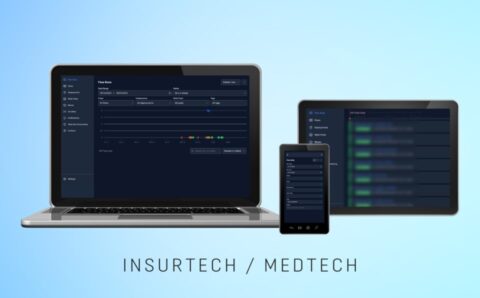
Robotic Process Automation (RPA) is a robust technology that employs software robots or “bots” that delegate and automate repetitive tasks and processes within businesses. The RPA software simulates human actions to execute rule-based tasks. In practice, it may be data entry, document processing (for instance, invoices, purchase orders, and customer forms), and customer support, among many others. The ability to take over the frequent assignments has made the RPA market valued at $3.7 billion in 2022, as Statista claims. It is forecasted to have a compound annual growth rate (CAGR) of 36.6% from 2022 to 2032. By 2032, the market is projected to reach a valuation of $81.8 billion.
Hence, automation is of immense importance for small businesses as it streamlines operations, cuts down manual errors, and elevates efficiency, bringing in the opportunity to allocate available resources wisely. Due to optimization, RPA allows companies to decrease operational costs, put more effort into core business tasks, and grow the team’s productivity. Moreover, when talking about startups, as well as small and medium-sized enterprises (SMEs), robotization can provide a competitive advantage by enabling them to adjust to market dynamics and customer demands seamlessly. Reading this article, you’ll discover the value of Robotic Process Automation for small businesses.
Table of Contents:
Pros of Using RPA for Small Businesses
The RPA technology offers numerous advantages for small businesses, ranging from enhanced productivity and cost savings to the highest accuracy and guideline adherence. Organizations that have applied RPA services reported a payback period of less than 12 months, with robots providing an average of 20% of full-time equivalent (FTE) capacity.
“RPA is democratizing automation. It empowers business users to automate processes without extensive coding or IT support, freeing up valuable resources and driving innovation across the organization.”
Frank Casale, the founder of the Institute for Robotic Process Automation & Artificial Intelligence (IRPA AI)
Increased Efficiency
Enhanced efficiency brought by RPA provides higher productivity and resource optimization, driving overall effectiveness and competitiveness. RPA is guaranteed to boost your business productivity by approximately 86%, as Deloitte claims, and here’s how.
Streamlined Repetitive Tasks
Robotic Process Automation for small businesses takes over day-to-day and repetitive tasks that are highly time and resource-consuming. These activities, such as data input, report generation, or inventory management, can be carried out much faster and with maximum precision by RPA bots. By automating these processes, employees are able to redirect their contributions to more strategic and value-added activities, consequently boosting workflow effectiveness across numerous domains, like Insurance, Telehealth, and eSport. To illustrate, with Quandri, insurance startups can elevate brokerage operations by seamlessly automating routine tasks and improving the teams’ efforts on strategic progress activities through the three advanced digital workers.
Reduction in Manual Errors
Human mistakes are inescapable in manual performance. According to IDC, organizations incur over $62.4 million annually due to human-made errors. Additionally, an analysis by the Uptime Institute highlights that human error, rather than infrastructure faults, is responsible for more than 70% of data center outages.
Robotic Process Automation for small businesses eliminates the possibility of errors by sticking to the predefined rules and executing the work consistently. This helps companies elevate data accuracy, reduce rework, as well as raise customer satisfaction and retention. Thus, startups can maintain high-quality performance standards using RPA services for Insurance, hospitality, or inventory management.
Cost Savings
By using RPA, you can gain significant cost savings with the delegation of regular tasks, reducing manual faults and elevating performance efficiency. As the Deloitte report indicates, the need for fewer teammates and the optimization and delegation of workloads ensures a cost reduction of about 59%.
Lower Operational Costs
Implementing RPA can lead to significant cost savings for small businesses. By automating repetitive tasks, companies can reduce the time and resources spent on manual labor. This translates to lower operational expenses related to labor costs, such as salaries, overtime payments, and training. Additionally, RPA software for small businesses helps operate more efficiently, thereby optimizing resource utilization and reducing overhead costs. Over the next three years, a significant majority, comprising 78% of those who have already adopted RPA, anticipate a substantial increase in their investments in robotic process automation, as the Deloitte report mentions. 53% of respondents have started the adoption of RPA, a number forecasted to rise to 72% within the next two years. If this tendency remains, RPA is guaranteed to achieve nearly universal adoption within the subsequent five years.
Reduced Need for Human Labor
With RPA handling repetitive tasks, small businesses can cut down their dependence on human labor for routine activities. Delegation of the work pressure from employees allows them to focus on duties they specialize in and minimizes the need for hiring additional staff to manage growing operational needs. By leveraging RPA, businesses can achieve higher productivity levels without the outgoings associated with new employees’ employment and onboarding. In 2022, a survey conducted by Robocorp found that 67% of respondents had invested in RPA technologies during 2021.
Enhanced Accuracy and Compliance
RPA boosts compliance, providing adherence to regulatory requirements with precision and consistency. Deloitte claims that RPA employment enhances compliance by 92%. Let’s discuss why you should leverage automation to meet your domain’s regulations and standards.
Consistency in Data Handling
By adhering to predefined rules and procedures, RPA guarantees consistency and precision in data handling flows. That’s why ImpactMyBiz predictions state that 92% of manufacturers report that RPA helped them enhance compliance and 90% claim that RPA has elaborated the level of quality and accuracy. In contrast to manual operating, bots don’t give in to fatigue, distractions, or variations in fruitfulness, providing reliable and error-free performance of tasks. Strong consistency positively impacts the quality of outputs and cuts down the risk of dissimilarities or imprecision in business workflow. This fact implies the undeniable benefits of RPA in Insurance, Healthcare, and many other industries.
Adherence to Regulatory Standards
Compliance with regulatory guidelines and industry-specific standards is inalienable for newly set businesses to eliminate penalties and legal repercussions. RPA helps achieve full compliance by introducing standardized processes and audit trails. Bots can accurately document each procedure stage, delivering a fully-fledged record for regulatory purposes. Apart from that, RPA software for small businesses allows adapting to modifications within the regulations by updating automated workflows as required, eliminating compliance risks.
Scalability and Flexibility
Robotic process automation is an essential technology aimed at boosting your flexibility and scalability to be the first one to adopt the latest innovations and meet dynamic market requirements.
“RPA is not a technology trend; it’s a strategic imperative. Organizations that fail to embrace automation risk falling behind their competitors in terms of productivity, agility, and innovation.”
John Haley, CEO of Willis Towers Watson
Ability to Scale Operations Easily
A frequently-faced issue of small businesses lies in scaling operations to cater to growth or changes in demand. In such cases, RPA equips market newcomers with scalability by allowing them to quickly adjust automation processes to meet ever-evolving requirements. Robotization acts as a powerful tool that can handle boosted transaction volumes or extend into new markets, providing seamless scalability with no significant investments in infrastructure or manpower. Put it in practice, 38% of managers indicate that compliance and enhancement are the core benefits of RPA, accompanied by productivity and improved performance (27%) based on PwC data.
Adaptability to Changing Business Needs
A dynamic business environment requires high rapidity and flexibility to stay competitive and relevant. For this reason, RPA makes it so much easier for small businesses to fit into dynamic market conditions, customer preferences, tastes, and technological advancements. Robotization software can be reconfigured or deployed for new tasks with minimal disruption, so organizations are able to respond rapidly to opportunities and challenges.
Cons of Using RPA for Small Businesses
While RPA offers numerous benefits for small businesses, it also presents a range of challenges and considerations. Let’s consider them and cover the techniques for addressing these proactively and strategically. By doing this, small businesses can leverage the power of RPA to ensure maximum progress and competitiveness in their niche.
Initial Investment and Implementation Challenges
Integration issues and organizational resistance can serve as barriers to the adoption of RPA software.
Cost of RPA Software and Setup
One of the primary drawbacks of adopting RPA for small businesses is the initial investment required to order software licenses and set up the automation infrastructure. Undoubtedly, RPA can lead to long-term cost savings, but the upfront expenses related to creating and implementing the technology may become a financial obstacle for businesses that have just started their journey and have limited resources.
Concerned About RPA Costs?
Learn the factors that influence RPA pricing and get tips for maximizing your ROI.
Learning Curve for Employees
Introducing RPA into the work environment necessitates a learning curve for the team that is accustomed to manual task execution. Training the members to examine and apply RPA opportunities effectively can be time-consuming and may disrupt daily performance. This makes small businesses need to allocate resources for onboarding and support to obtain a smooth transition to automated workflows.
Potential Job Displacement Concerns
Automated processes may replace certain repetitive tasks traditionally performed by humans, which may lead to certain negative consequences for your business.
Impact on Existing Workforce
The robotization of repetitive tasks via RPA may raise concerns regarding job displacement among currently assembled staff. As bots take over routine activities, there is a risk of workforce reduction or restructuring, resulting in job insecurity and morale issues within the organization. To avoid this obstacle, small businesses should describe transparently the role of RPA to the employees and efficiently address concerns about work stability.
Reskilling Requirements
To mitigate job displacement concerns, startups may need to financially support reskilling programs and outfit employees with the knowledge required to seamlessly and cohesively perform with RPA technology. This may engage training workers to monitor and manage automated flows, investigate data extracted by robots, or focus on more sophisticated tasks that require live manual analysis and creativity. Nonetheless, reskilling activities require additional time and resources, which may be problematic for small businesses with limited capacity.
Dependency on Technology
The risk of over-reliance on RPA is a challenge that may lead to decreased human oversight and potential overlooking of nuanced decision-making cases.
Vulnerability to Technical Issues
Small businesses leaning heavily on RPA software may face vulnerabilities associated with software bugs, system updates, or compatibility issues. Any disruptions or malfunctions in RPA solutions could interfere with stable business workflow and lead to downtime, decreasing the level of efficiency and client service. Besides, SMEs occasionally lack the IT infrastructure or expertise to cope with technical challenges quickly, so prolonged downtime and financial losses may occur.
Risk of System Failures
RPA systems are susceptible to failures or errors, which can occur due to software glitches, network outages, or hardware malfunctions. Small businesses must consider the potential risks of relying solely on automated processes and implement contingency plans to mitigate the impact of system failures. Maintaining backup systems, implementing disaster recovery protocols, and conducting regular audits are essential measures to minimize downtime and data loss.
Limited Scope of Automation
The smaller scope of automation, restricting RPA adoption to rule-based and repetitive tasks, can be considered a drawback as it may not cater to more complex cognitive processes requiring a human-like view.
Inability to Automate Complex Tasks
While RPA excels at taking over repetitive work, it may struggle with handling complex operations that necessitate human engagement or emotional intelligence. Tasks that comprise peculiar decision-making, customer relationships, or unexpected cases may be challenging to fully and effectively robotize. This should be a consideration for startups that should recognize the limitations of RPA technology and identify areas where human intervention is essential. This way, they are able to ensure optimal performance and balance the workload among the live competence and automation capacities.
Need for Human Intervention in Certain Scenarios
Even bearing all the advances in RPA capabilities in mind, there are still instances where human involvement is indispensable. Complex problem-solving, dealing with exceptions, and interpreting unstructured data are the practical cases that may make manual intelligence critical. The reasonable use of automation and human expertise can help achieve optimal outcomes and maintain flexibility in operations.

Robot Factory
Robot Factory software offers insurance brokers a comprehensive automation tool, optimizing document management with significant time savings.

AI Platform
The AI-Assisted platform PLANEKS developed improves healthcare admin by automating tasks, optimizing resources, and enhancing service quality.

Santé.app
Our creation, Santé.app, automates insurance selection with surveys, delivering fully customized health insurance options based on user preferences.
Best Practices for Small Businesses Considering RPA Implementation
Let’s now move on to the core recommendations to follow when adopting RPA for small businesses. These suggestions can make the implementation of this technology seamless and efficient, with no disruptions to your current workflow.
Assessing Business Processes for Automation Suitability
Before beginning RPA implementation, small businesses should in-depthly evaluate their existing business flows to determine tasks that can be efficiently automated.
-
- Process mapping. Start by outlining all current processes to define their complexity, regularity, and potential for automation. The prioritized ones should be daily, procedural, and algorithmic tasks that take too much time and are prone to failure.
- Automation suitability criteria. Figure out the indicators for tracking the suitability of automation processes. Consider aspects such as volume, frequency, standardization, and predictability of processes. It’s reasonable to put first the processes that ensure the highest return on investment (ROI) and align with the core business aims.
- Pilot testing. Fulfill pilot tests or proof-of-concept projects to validate the feasibility and effectiveness of automating selected processes. Assess the impact of automation on the indicators set earlier before scaling up the fully-fledged implementation. For example, these may refer to productivity, accuracy, and cost savings.
Choosing the Right RPA Solution
The choice of the appropriate solution is crucial for the success of implementation, further adoption, and cost recoup. When selecting Robotic Process Automation for small businesses, we offer you to consider these factors.
-
- Scalability and flexibility. Opt for an RPA platform that can scale with the expanding needs of the business and cater to the changes in your workflow or technology. Select features such as smooth and straightforward integration with existing systems, cloud compatibility, and support for diverse automation requirements.
- Security and compliance. Selecting an RPA solution that adheres to powerful security protocols and compliance standards is critical. Make sure that the chosen software reflects industry regulations, protecting sensitive data and maintaining a secure environment throughout the automation process.
- User-friendly interface. The choice should be made toward the RPA solution with an intuitive and easy-to-use interface that allows non-technical users to design, deploy, and manage automation workflows. Convenience and accessibility are critical for enabling employees to apply RPA capacities effectively.
Employee Training and Change Management
Successful RPA implementation requires efficient employee onboarding and change management activities to facilitate acceptance and full adoption. Key considerations in this aspect cover the following.
-
- Training programs. Provide comprehensive training programs to consult employees on RPA technology usage, its values, and the way the entire automation process occurs. Offer hands-on onboarding sessions, workshops, and online resources to elevate proficiency and confidence in leveraging RPA tools.
- Change communication. Share transparently with employees the reasons behind RPA implementation, its impact on their responsibilities, and the solid benefits for the organization. Concentrate on the opportunities for upskilling, career growth, and value-added contributions.
- Empowerment and engagement. Assist employees in taking part in the automation roadmap by assembling their feedback, ideas, and suggestions for process perfecting. When making software updates, you may encourage collaboration between business stakeholders, IT teams, and RPA developers to provide absolute alignment with organizational goals and priorities.
Monitoring and Continuous Improvement
Effective monitoring and ongoing improvement are the two activities vital for optimizing RPA performance and maximizing ROI. Here, the following practices can help.
-
- Performance metrics. Key performance indicators (KPIs) can efficiently measure the impact of RPA on business outcomes, such as productivity gains, cost savings, error reduction, and process cycle times. Regularly monitor and check KPIs to determine areas for enhancement and track the progress of automation initiatives.
- Feedback mechanisms. Establish feedback channels to retrieve insights from employees, end-users, stakeholders, and RPA bots themselves. Ask your team to report any issues, challenges, or suggestions for process refinement. Then, based on this feedback, businesses can iterate automation workflows, address pain points, and elevate user experience.
- Continuous optimization. Streamline RPA workflows according to performance data, insights, and raising business requirements. Regularly check and update automation scripts, rules, and configurations to provide relevance, efficiency, and compliance with changing regulations
Empower Your Business with RPA
Discover how our expert RPA services can streamline your operations and boost efficiency.
Conclusion
As we may grasp, RPA technology offers significant benefits for small businesses, being their dedicated assistant in increasing efficiency, saving cost, enhancing performance accuracy, and ensuring scalability. The challenges represented by robotization exist, but the techniques for their elimination can efficiently liquidate any obstacles on your journey to automation and efficiency, ensuring skyrocketed performance and a high ROI rate.
Furthermore, strategic decision-making is integral for small businesses considering RPA implementation. To make the right choice, it is essential to analyze business processes, goals, and resources primarily. This way, businesses can seamlessly adopt RPA and obtain the full robustness of automation while mitigating risks and maximizing results.
The future for RPA adoption in small businesses is promising, with continued technological advancements and increasing awareness of its benefits. As automation becomes more accessible and affordable, small businesses will likely invest in RPA as a strategic tool for driving growth, competitiveness, and innovation.
In case you are considering using this technology to elaborate your business operation, we highly recommend you explore the value of RPA software for small businesses. Discover insights, market practices, and techniques prior to making the final decision. Let’s continue to investigate the transformative power of RPA for small businesses and their further market prosperity.

